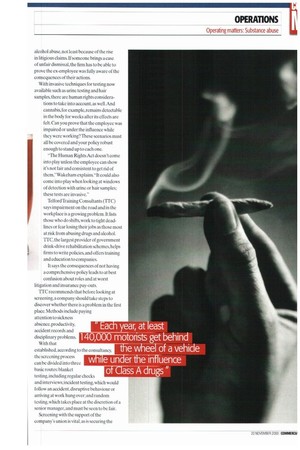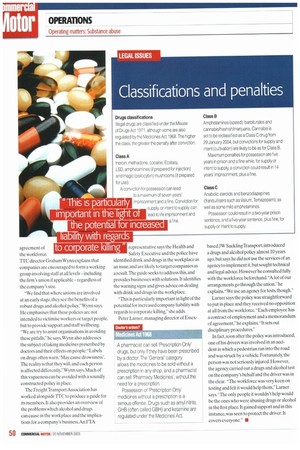TESTING TIMES
Page 48

Page 49

Page 50

If you've noticed an error in this article please click here to report it so we can fix it.
The number of road users abusing alcohol and drugs is rising.
Chris Tindall looks
at how a company
can address this by protecting itself and its employees.
The RAC Foundation recently published figures concerning road fatalities, and the statistics expose a disturbing trend among drivers in the UK.The survey claims 25% of deaths on the road are caused by drivers under the influence of drugs, while 15% involve those who have consumed alcohol.
But is only when these percentages are converted into numbers that the scale of the problem really hits home.Around 200,000 people admit to having driven after taking cannabis or marijuana and each year, at least 140,000 motorists get behind the wheel of a vehicle while under the influence of Class A drugs such as cocaine, heroin or Ecstasy. How can you he sure none of your drivers is among them? And that's even before you look at the arguably greater problem of the effects which prescriptive or over-the-counter medicines may have on drivers.
Employers' duty
The problem extends beyond the use of vehicles, however, and operators may also be concerned by the effects of substance abuse on productivity,absenteeism, lateness and disputes, as well as the human and health costs to individuals. Indeed, employers have a general duty under the Health and Safety at Work Act 1974 to ensure the health, safety and welfare of employees — the alternative is prosecution. So how does a company go about safeguarding itself against this increasing problem, and how can you detect for certain that employees are under the influence?
Drugs policy advisory body Hampton Knight offers a possible solution. it provides companies with a template to begin with: a policy in a generic format that is adapted to meet each firm's requirements.The whole process is fairly long and can take anything from six months to a year to implement, because of the time taken to change a company's terms and conditions. "The key thing to a policy is that it must apply to everyone in the company," says Hampton Knight managing director Chris Wakeham."We say, 'Here are the options and this is what we can provide.' We can tailor it to the company."
This is important. Some companies want to test their employees for substance abuse on a regular basis: others only once or twice a year. For the latter,it does not make financial sense to invest in expensive testing equipment when you can pay for an independent collection service— this also avoids the complexities of proving that the worker who carries out the testing has been competently trained.
Wakeham says it is important for companies to have an up-to-date policy for drugs and alcohol abuse. not least because of the rise in litigious claims. If someone brings a case of unfair dismissal, the firm has to be able to prove the ex-employee was fully aware of the consequences of their actions.
With invasive techniques for testing now available such as urine testing and hair samples, there are human rights considerations to take into account, as well. And cannabis, for example, remains detectable in the body for weeks after its effects are felt. Can you prove that the employee was impaired or under the influence while they were working? These scenarios must all be covered and your policy robust enough to stand up to each one.
The Human Rights Act doesn't come into play unless the employee can show it's not fair and consistent to get rid of them," Wakeham explains." It could also come into play when looking at windows of detection with urine or hair samples; these tests are invasive."
Telford Training Consultants (TTC) says impairment on the road and in the workplace is a growing problem. It lists those who do shifts, work to tight deadlines or fear losing their jobs as those most at risk from abusing drug and alcohol. ITC, the largest provider of government drink-drive rehabilitation schemes, helps firms to write policies, and offers training and education to companies.
It says the consequences of not having a comprehensive policy leads to at best confusion about roles and at worst litigation and insurance pay-outs.
TTC recommends that before looking at screening. a company should take steps to discover whether there is a problem in the first place. Methods include paying attention to sickness absence,productivity, accident records and disciplinary problems.
With that testing. including regular checks and interviews; incident testing. which would follow an accident, disruptive behaviour or arriving at work hung over: and random testing, which takes place at the discretion of a senior manager, and must be seen to be fair.
Screening with the support of the company's union is vital, as is securing the agreement of the workforce. TTC director Graham Wynn explains that companies are encouraged to form a working group involving staff at all levels — including the firm's union if applicable — regardless of the company's size.
"We find that where unions are involved at an early stage. they see the benefits of a robust drugs and alcohol policy," Wynn says. He emphasises that these policies are not intended to victimise workers or target people. but to provide support and staff wellbeing. -We are try to assist organisations in avoiding these pitfalls." he says. Wynn also addresses the subject of taking medicines prescribed by doctors and their effects on people:"Labels on drugs often warn. 'May cause drowsiness'. The reality is that they will, and each person is affected differently." Wynn says. Much of this vagueness can be avoided with a soundly constructed policy in place.
The Freight Transport Association has worked alongside rrc to produce a guide for its members. It also provides an overview of the problems which alcohol and drugs can cause in the workplace and the implications for a company's business.An FTA representative says the Health and Safety Executive and the police have identified drink and drugs in the workplace as an issue, and are likely to target companies as a result.The guide seeks to address this, and provides businesses with solutions. It identifies the warning signs and gives advice on dealing with drink and drugs in the workplace.
"This is particularly important in light of the potential for increased company liability with regards to corporate killing.she adds.
Peter Lamer, managing director of Essex based JW SucklingTransport. introduced a drugs and alcohol policy almost 10 years ago. but says he did not use the services of an agency to implement it, but sought technical and legal advice. However he consulted fully with the workforce beforehand."A lot of our arrangements go through the union." he explains. "We use an agency for tests, though."
Lamer says the policy was straightforward to put in place and they received no opposition at all from the workforce. "Each employee has a contract of employment and a memorandum of agreement," he explains."It sets out disciplinary procedures.
In fact,soon after the policy was introduced, one of his drivers was involved in an accident in which a pedestrian ran into the road and was struck by a vehicle. Fortunately, the person was not seriously injured. However, the agency carried out a drugs and alcohol test on the company's behalf and the driver was in the clear. -The workforce was very keen on testing and felt it would help them," Lamer says:The only people it wouldn't help would be the ones who were abusing drugs or alcohol in the first place. It gained support and in this instance, was seen to protect the driver. It covers everyone." •
































































































































































































